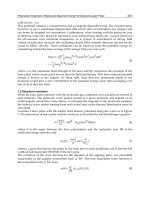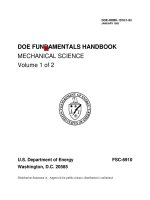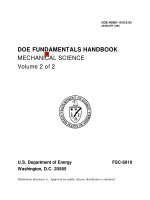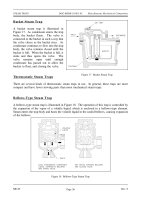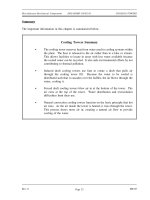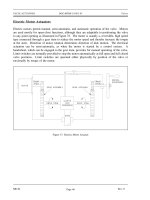Mechanical Science HandbooksMechanical Science Handbooks 10000 Part 13 pps
Bạn đang xem bản rút gọn của tài liệu. Xem và tải ngay bản đầy đủ của tài liệu tại đây (62.83 KB, 2 trang )
Pumps DOE-HDBK-1018/1-93 POSITIVE DISPLACEMENT PUMPS
Figure 20 Diaphragm Pump
Positive Displacement Pump Characteristic Curves
Positive displacement pumps deliver a definite volume of
Figure 21
Positive Displacement Pump
Characteristic Curve
liquid for each cycle of pump operation. Therefore, the
only factor that effects flow rate in an ideal positive
displacement pump is the speed at which it operates. The
flow resistance of the system in which the pump is
operating will not effect the flow rate through the pump.
Figure 21 shows the characteristic curve for a positive
displacement pump.
The dashed line in Figure 21 shows actual positive
displacement pump performance. This line reflects the
fact that as the discharge pressure of the pump increases,
some amount of liquid will leak from the discharge of the
pump back to the pump suction, reducing the effective
flow rate of the pump. The rate at which liquid leaks
from the pump discharge to its suction is called slippage.
Rev. 0 ME-03
Page 27
POSITIVE DISPLACEMENT PUMPS DOE-HDBK-1018/1-93 Pumps
Positive Displacement Pump Protection
Positive displacement pumps are normally fitted with relief valves on the upstream side of their
discharge valves to protect the pump and its discharge piping from overpressurization. Positive
displacement pumps will discharge at the pressure required by the system they are supplying.
The relief valve prevents system and pump damage if the pump discharge valve is shut during
pump operation or if any other occurrence such as a clogged strainer blocks system flow.
Summary
The important information in this chapter is summarized below.
Positive Displacement Pumps Summary
The flow delivered by a centrifugal pump during one revolution of the impeller depends
upon the head against which the pump is operating. The positive displacement
pump delivers a definite volume of fluid for each cycle of pump operation
regardless of the head against which the pump is operating.
Positive displacement pumps may be classified in the following ways:
Reciprocating piston pump
Gear-type rotary pump
Lobe-type rotary pump
Screw-type rotary pump
Moving vane pump
Diaphragm pump
As the viscosity of a liquid increases, the maximum speed at which a reciprocating
positive displacement pump can properly operate decreases. Therefore, as viscosity
increases, the maximum flow rate through the pump decreases.
The characteristic curve for a positive displacement pump operating at a certain
speed is a vertical line on a graph of head versus flow.
Slippage is the rate at which liquid leaks from the discharge of the pump back to
the pump suction.
Positive displacement pumps are protected from overpressurization by a relief valve
on the upstream side of the pump discharge valve.
ME-03 Rev. 0
Page 28
